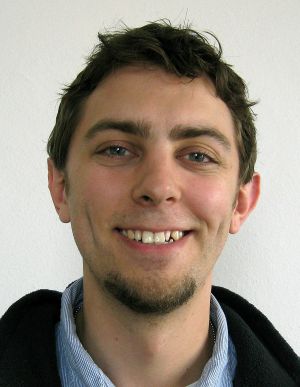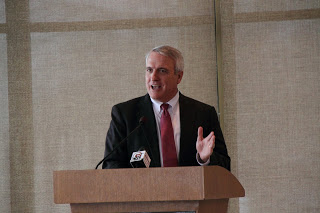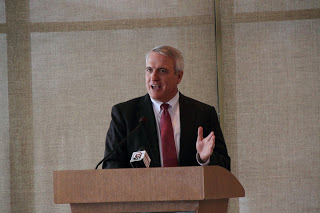
ACTION ALERT: Support Highland Wind Farm
|
DATE:
|
February 25, 2013
|
|
SUBJECT:
|
Fate of Highland Wind Farm in St. Croix County Hangs in the Balance
|

|
DATE:
|
February 25, 2013
|
|
SUBJECT:
|
Fate of Highland Wind Farm in St. Croix County Hangs in the Balance
|
Since early 20212, RENEW Wisconsin has been advocating for Clean Energy Choice policy, and we were thrilled to find this piece in the La Crosse Tribune from Scott Karel of the Wisconsin Farmers Union:
Wisconsin citizens have only have two ways to purchase energy for their homes or businesses: either they buy it from the local electric utility or they pay to have their own alternative energy sources installed on their property.
 |
| Scott Karel is a government relations associate for Wisconsin Farmers Union |
This effectively gives utility companies a monopoly because most people don’t have the disposable income to install such devices on their own.
However, with a little help from state legislators, Wisconsin residents could benefit from more competition in this market while at the same time producing green energy for their own personal consumption.
Third-party owned renewable-energy systems have become an effective method to promote the growth and production of green energy at no additional cost to ratepayers or taxpayers. This system, known as “clean energy choice,” allows a third party to enter into a contract with a farmer, homeowner or business to lease their roof space.
In return, the third-party company will install, operate and maintain, at no cost to the landowner, a solar panel, manure digester, wind turbine or other renewable energy system on their property. The energy from these systems either passes directly to the customer or is sold to the local utility.
Clean energy choice systems are a benefit to all Wisconsin residents for a variety of reasons. For the customers who enter into these agreements, they are able to lock in their utility rates at a fixed amount for the length of the contract, which is typically anywhere from 10 to 20 years.
A fixed energy rate is one of the main reasons that Kohl’s department stores chose to install solar panels on around 100 of its stores located in states that expressly allow third-party ownership of renewable energy systems.
Clean energy choice also creates more competition in the energy market and promotes renewable energy without using government subsidies.
Finally, allowing third-party energy agreements will support the state’s economy by creating more business for the estimated 135 companies in Wisconsin that participate in the solar market.
Currently, laws in more than 20 states — including Illinois, Michigan and Ohio — specifically allow third-party sale of renewable energy to their customers. However, in about 20 other states, including Wisconsin, the law is unclear about whether this type of agreement is allowable.
Third-party energy companies will not attempt to enter into contracts with landowners until there is clarification on this law for fear of being regulated as a public utility.
We think that the energy certainty provided by these agreements would benefit many farmers in Wisconsin who happen to have plenty of wind or open roof space on their buildings but may not have the extra money to install their own wind turbines or solar panels. No law should prevent customers who want to have access to clean energy simply because they cannot afford to install the system on their own.
If you would like to learn more about the Clean Energy Choice legislation being advanced in the Legislature this year, contact me at skarel@wisconsinfarmersunion.com or 608-234-3741.
Scott Karel is a government relations associate for Wisconsin Farmers Union.
Find the article in it’s original publication on The LaCrosse Tribune here.

Just before RENEW’s policy summit, the keynote speaker, former Governor of Colorado, Bill Ritter, did an excellent interview on Milwaukee Public Radio. Listen to the interview below, or read the article “Colorado’s Renewable Energy Economy Offers Model for Wisconsin” with Susan Bence (attached below).
The Port of Milwaukee announced this week that the wind turbine that supplies energy to the port’s administration building has been paying dividends to the city. In less than a year of operation, the turbine shifted electrical costs at the port by almost $15,000 dollars. In fact, the electrical utility actually paid the port for the surplus energy it produced.
 |
| Bill Ritter, delivering the keynote at RENEW ‘s Summit |
This news is likely music to the ears of former Colorado Governor Bill Ritter, who championed alternative sources of energy during his time in office. Ritter is now the Director for the Center for the New Energy Economy at Colorado State University, where he is helping states across the country create plans to implement renewable energy economies. And he’s in Wisconsin this week as the keynote speaker at the RENEW’s Energy Policy Summit in Madison.
Aggressive renewable energy standards
Ritter says energy issues first emerged as a priority in his political career when he was campaigning for governor in 2005 and 2006. His campaign focused on renewable energy as a way to move Colorado forward and it became a pillar of his administration’s agenda. Once in office, he signed 57 clean energy bills.
Now Colorado is one of the leaders in the country when it comes to alternative energy. Ritter says the state is on the path to supplying 30 percent renewable energy by 2020, “one of the most aggressive renewable energy standards in America.”
Today, Wisconsin has a renewable energy standard of 10 percent by 2015, but Ritter says a lot of that power comes from outside the state, whereas Colorado’s is mostly in-state.
“Actually our cost of power relative to the rest of America has gotten cheaper as we’ve pushed this very aggressive clean energy agenda,” he says. “We had a day last April where our primary and best run utility got 57 percent of all its energy that it provided Colorado customers from wind alone.”
Building a ‘new energy economy’
Of course, the cost has gone down because of broad deployment of such methods. In building this “new energy economy,” Ritter says Colorado attracted manufacturing companies that focused on wind and solar energy, and promoted research and development among private companies and government entities.
“We really have this ecosystem built around advanced energy or clean energy, and really trying to say, ‘It could be domestic, it could be clean, it could help us create job and we can protect rate fares in the process,’” he says.
Facing challenges
But Ritter admits creating this “new energy economy” didn’t come without its hurdles. Some utilities and critics opposed the government creating a renewable energy standard, which at first was 10 percent by 2015.
“People say we don’t like standards because it’s a mandate,” Ritter says. “Quite frankly the entirely energy sector has been heavily regulated since it’s inception, and so to say something like renewable energy standards are a mandate and we should do away with it, I think it’s just wrong, because everything in energy is based on regulation. It is not the operation of free market and it’s that way by intention.”
So voters went to the ballot and passed the standard. Soon, after the state legislature put in a rate cap, the utilities were on board, approving of a doubling of the standard and eventually a tripling of it. Ritter says that’s because the utilities saw that they could make the benchmark, they could hold rates in check and get returns on their investment, and they could make customers happy.
“Actually our cost of power relative to the rest of America has gotten cheaper as we’ve pushed this very aggressive clean energy agenda.” -former Colorado governor Bill Ritter
Dealing with the utilities was not the only problem the state encountered in getting behind renewable energy. The coal industry, which provided many mining jobs in the state, felt their market share was being taken by renewable energy. A plan to pay residents who built their own system and put power back onto the grid required some finagling. And naturally, political adversaries made it difficult for the legislation to get to Ritter’s desk.
“I think the public liked it and got it, but I still had a difficult time politically with it, even with public support, because it doesn’t have the sort of intensity, the political intensity, that other issues might like the economy or job creation,” Ritter says.
He says his opponents claimed such an energy policy would lose jobs in the state, at a time when job creation was at a premium.
“That was really an awful thing to have said about you,” he says. “But our clean energy and clean tech sector wound up being the only sector that grew during the worst recession since the Great Depression in Colorado.”
Now Colorado is second in the country for solar jobs and number one per capita for employment for clean energy jobs overall, Ritter says.
Pushing the agenda
Based on his experience in Colorado, Ritter has some advice for Wisconsin in committing to renewable energy, which he says works handily with a free market. Leasing solar installations on buildings is one way to start.
“Last year over 80 percent of the rooftops in Colorado that installed solar were leased systems, so it’s a great economic development driver,” he says, citing similar success in California and Arizona.
At the Center for the New Energy Economy, Ritter says he is trying to push this whole agenda forward at the state level, from the financing to the R&D on advanced energy technologies to the practical implementation.
“How do we push this whole agenda forward at the state level, so a state can look at their energy economy and say, ‘We’re really about the 21st century,” and we’re tying domestic energy use with environmental issues, (and) economic development,” he says.
See the original article here.

Just before RENEW’s policy summit, the keynote speaker, former Governor of Colorado, Bill Ritter, did an excellent interview on Milwaukee Public Radio. Listen to the interview below, or read the article “Colorado’s Renewable Energy Economy Offers Model for Wisconsin” with Susan Bence (attached below).
The Port of Milwaukee announced this week that the wind turbine that supplies energy to the port’s administration building has been paying dividends to the city. In less than a year of operation, the turbine shifted electrical costs at the port by almost $15,000 dollars. In fact, the electrical utility actually paid the port for the surplus energy it produced.
 |
| Bill Ritter, delivering the keynote at RENEW ‘s Summit |
This news is likely music to the ears of former Colorado Governor Bill Ritter, who championed alternative sources of energy during his time in office. Ritter is now the Director for the Center for the New Energy Economy at Colorado State University, where he is helping states across the country create plans to implement renewable energy economies. And he’s in Wisconsin this week as the keynote speaker at the RENEW’s Energy Policy Summit in Madison.
Aggressive renewable energy standards
Ritter says energy issues first emerged as a priority in his political career when he was campaigning for governor in 2005 and 2006. His campaign focused on renewable energy as a way to move Colorado forward and it became a pillar of his administration’s agenda. Once in office, he signed 57 clean energy bills.
Now Colorado is one of the leaders in the country when it comes to alternative energy. Ritter says the state is on the path to supplying 30 percent renewable energy by 2020, “one of the most aggressive renewable energy standards in America.”
Today, Wisconsin has a renewable energy standard of 10 percent by 2015, but Ritter says a lot of that power comes from outside the state, whereas Colorado’s is mostly in-state.
“Actually our cost of power relative to the rest of America has gotten cheaper as we’ve pushed this very aggressive clean energy agenda,” he says. “We had a day last April where our primary and best run utility got 57 percent of all its energy that it provided Colorado customers from wind alone.”
Building a ‘new energy economy’
Of course, the cost has gone down because of broad deployment of such methods. In building this “new energy economy,” Ritter says Colorado attracted manufacturing companies that focused on wind and solar energy, and promoted research and development among private companies and government entities.
“We really have this ecosystem built around advanced energy or clean energy, and really trying to say, ‘It could be domestic, it could be clean, it could help us create job and we can protect rate fares in the process,’” he says.
Facing challenges
But Ritter admits creating this “new energy economy” didn’t come without its hurdles. Some utilities and critics opposed the government creating a renewable energy standard, which at first was 10 percent by 2015.
“People say we don’t like standards because it’s a mandate,” Ritter says. “Quite frankly the entirely energy sector has been heavily regulated since it’s inception, and so to say something like renewable energy standards are a mandate and we should do away with it, I think it’s just wrong, because everything in energy is based on regulation. It is not the operation of free market and it’s that way by intention.”
So voters went to the ballot and passed the standard. Soon, after the state legislature put in a rate cap, the utilities were on board, approving of a doubling of the standard and eventually a tripling of it. Ritter says that’s because the utilities saw that they could make the benchmark, they could hold rates in check and get returns on their investment, and they could make customers happy.
“Actually our cost of power relative to the rest of America has gotten cheaper as we’ve pushed this very aggressive clean energy agenda.” -former Colorado governor Bill Ritter
Dealing with the utilities was not the only problem the state encountered in getting behind renewable energy. The coal industry, which provided many mining jobs in the state, felt their market share was being taken by renewable energy. A plan to pay residents who built their own system and put power back onto the grid required some finagling. And naturally, political adversaries made it difficult for the legislation to get to Ritter’s desk.
“I think the public liked it and got it, but I still had a difficult time politically with it, even with public support, because it doesn’t have the sort of intensity, the political intensity, that other issues might like the economy or job creation,” Ritter says.
He says his opponents claimed such an energy policy would lose jobs in the state, at a time when job creation was at a premium.
“That was really an awful thing to have said about you,” he says. “But our clean energy and clean tech sector wound up being the only sector that grew during the worst recession since the Great Depression in Colorado.”
Now Colorado is second in the country for solar jobs and number one per capita for employment for clean energy jobs overall, Ritter says.
Pushing the agenda
Based on his experience in Colorado, Ritter has some advice for Wisconsin in committing to renewable energy, which he says works handily with a free market. Leasing solar installations on buildings is one way to start.
“Last year over 80 percent of the rooftops in Colorado that installed solar were leased systems, so it’s a great economic development driver,” he says, citing similar success in California and Arizona.
At the Center for the New Energy Economy, Ritter says he is trying to push this whole agenda forward at the state level, from the financing to the R&D on advanced energy technologies to the practical implementation.
“How do we push this whole agenda forward at the state level, so a state can look at their energy economy and say, ‘We’re really about the 21st century,” and we’re tying domestic energy use with environmental issues, (and) economic development,” he says.
See the original article here.
RENEW Wisconsin received a lot of positive press feedback after the 2013 renewable energy policy summit, “Powering Positive Action”. Here is a great press release from SC Johnson, reflecting on their award – find the original here.
Company Presented with “Renewable Energy Customer-Generator of the Year” Award for Advanced Wind Turbine Technology and Other Environmental Efforts
RACINE, Wis., Jan. 11, 2013 – Reflecting SC Johnson’s dedication to the environment, RENEW Wisconsin today awarded it the “Renewable Energy Customer-Generator of the Year” honor, specifically citing the company’s achievements in using renewable energy in its global manufacturing operations. The independent nonprofit organization leads and represents businesses, organizations and individuals seeking cleaner, renewable energy in Wisconsin.
“To be recognized with other Wisconsin companies that also champion clean energy is truly an honor and speaks to the priorities of the business community in our state,” said Kelly M. Semrau, Senior Vice President of Global Corporate Affairs, Communication and Sustainability at SC Johnson. “We are grateful for the support of RENEW Wisconsin and their dedicated efforts to advance clean energy policies that put Wisconsin at the forefront of environmental leadership.”
SC Johnson’s commitment to clean energy was recently reaffirmed in December 2012 with the installation of two 415-foot wind turbines at Waxdale, the company’s largest global manufacturing facility in Mt. Pleasant, Wis. These turbines – the first of their kind in the state – will produce about eight million kilowatt hours (kWh) of electricity annually – enough to power 700 homes in a year. Combined with two cogeneration turbines that have been in place since the mid-2000s, the facility is now able to produce an average of 100 percent of its electrical energy onsite.
“SC Johnson is doing outstanding work as a renewable self-generator to make wind energy a smart and viable alternative to power their operations,” said Michael Vickerman, Program and Policy Director at RENEW Wisconsin. “We were thrilled to recognize the company for powering positive action in Wisconsin using wind energy, and we are proud that the policies RENEW has advanced have helped SC Johnson achieve this success.”
SC Johnson is emerging as a regional and national leader for its clean-energy initiatives, particularly those related to wind energy. With the commissioning of the wind project at Waxdale, the company is now the only manufacturer in the country that has installed Vensys turbines – the latest in wind turbine technology, meaning less maintenance and higher energy yields than traditional systems.
SC Johnson’s Worldwide Leadership in Renewables
In addition to the wind turbine project at Waxdale, SC Johnson added three SWIFT mini wind turbines to the roof of its Lowell, Ark., sales office, capable of generating as much as 3,600 kilowatt hours of electricity annually. These reduce carbon dioxide emissions equal to about 280 gallons of gasoline. In the Netherlands, a 262-foot-tall wind turbine helps power the SC Johnson European manufacturing facility.
The company has also been making strides in Indonesia since SC Johnson launched a biofuel initiative that converts waste palm shells as a fuel source to heat water for mosquito coil production. This cuts greenhouse gas emissions at the factory by more than 15 percent and reduces local diesel fuel use by 80 percent. Each of these projects brings SC Johnson closer to the company’s goal of increasing worldwide renewable energy use to 44 percent of total electricity by 2016.